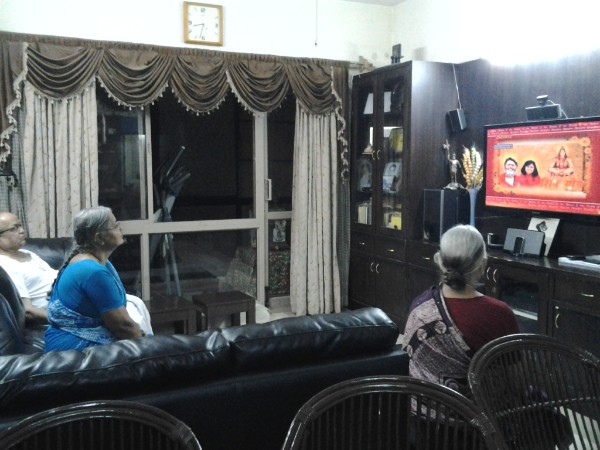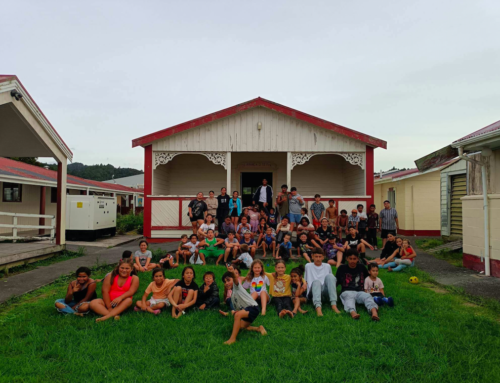by Sahana Udupa and Purnima Mankekar
AES is pleased to share this interview celebrating our 25th anniversary American Ethnologist article from 1993. Sahana Udupa, professor of anthropology at Ludwig Maximilians-Universität München interviews Purnima Mankekar, professor of anthropology at the University of California at Los Angeles about her article “National Texts and Gendered Lives: An Ethnography of Television Viewers in a North Indian City.”
This interview reflects on Mankekar’s formative intellectual inspirations, her understandings of affect and conjunctural ethnography, and the role of digital media in shaping political life.

Sahana Udupa: Your article “National Texts and Gendered Lives,” which was published in American Ethnologist in 1993, opened up a new area of inquiry for studies of postcolonial societies, and made a pathbreaking contribution to the still nascent field of media anthropology. You discussed the significance of mass media in the construction of national and gendered subjects. Looking back, how did you envision such a project?
Purnima Mankekar: That project was a product of personal biography and intellectual training. I had long been acutely aware of the importance of popular culture and media. For one, I was an avid consumer of Indian pop culture, including Doordarshan programs. But I also grew up with a feminist mother who was a journalist embedded in a very vibrant media scene and an activist in the Indian women’s movement. I studied English as an undergraduate but I couldn’t imagine understanding media from perspectives that were exclusively textual. So I turned to sociology at Jawaharlal Nehru University in India, where I learned social theory and Marxist theory both within the classroom and outside it. This training was supplemented when I entered the doctoral program in anthropology at the University of Washington. There I learned approaches from the so-called Birmingham School of cultural studies which gave me the theoretical vocabulary to examine the politics of media. I also encountered, entirely by chance, This Bridge Called my Back, the work of Gloria Anzaldua, the Combahee River Collective, Audre Lorde, bell hooks and many others. Thus began my engagement with Women of Color feminism and my efforts to start a conversation, in my own mind and with my classmates and teachers, between Women of Color and postcolonial feminisms.
It was this convergence of formative influences that shaped my dissertation project and, eventually, my first book. I was not interested in “active audiences” per se but, instead, was curious about what the complex responses of television viewers suggest about their uneven and heterogeneous interpellation by hegemonic discourses of nationalism and, in particular, gender, sexuality, caste, religion, and class.
SU: Another important area of concern introduced in the article was the quotidian media context of disciplining gendered bodies. This interest has continued throughout your career. This has inspired many researchers, including me, to reassess such subtle signaling as well as overt conditioning of female subjectivities in the digital age. How did you begin to notice gendered relations during your fieldwork, and why did you believe it was important to understand cultural nationalism?
PM: I want to clarify at the outset that my interest in gendered relations preceded my fieldwork. In fact, it was my interest in gender, feminist politics, and feminist theory – and my excitement in engaging feminist critiques of colonialism and nationalism – that brought me to this project. I was living in Delhi during the meticulously-planned pogroms against Sikhs in the aftermath of Indira Gandhi’s assassination in 1984. And the centrality of gendered and sexual violence at the core of Hindu nationalism sweeping the country in the early-1990s was inescapable. The work of feminists in India was absolutely foundational to my thinking about Hindu nationalism and postcoloniality — the pioneering and paradigm-shattering work of Lata Mani, Uma Chakravarty and Susie Tharu, the We Were Making History volume, Rajeshwari Sundar Rajan’s powerful theorizations of the “scandal” of the Indian state, and Urvashi Butalia’s magnificent book on women caught in the crossfires of communal (and nationalist) violence during Partition. These scholars provided me with analytics that I continue to find generative so many decades later.
Now when I look back I realize that in Gendered Texts as well as in Screening Culture what I was really trying to understand was the formation of national(ist) affect; I did not, however, learn the theoretical vocabulary for the study of affect until many years later when I started working on the Unsettling India book. My turn to affect was precipitated by the ubiquity of state-endorsed violence against Sikhs and Muslims in the U.S. after September 11, 2001. Rather than ask where the hatred came from or why people perpetrated hate violence, I was concerned with tracking how hate circulated in a not-always-nameable yet incredibly material and consequential way, gathering force through its very movement, sticking (to use Sarah Ahmed’s felicitious word) to certain bodies more than others, and rendering those bodies targets of violence. What was being generated and circulated was affect, and this was an intensity that generated social action and agency. It was xenophobic, racist and, at its core, nationalist; it had everything to do with the state (hence my insistence on the term affective regimes). It was capacious and swept up entire communities in its sway. This reinforced for me the urgency of studying media as nodes in the generation and circulation of affect.
SU: You have called for “conjunctural ethnography” that takes contingency as a key aspect of ethnography’s object of analysis, emphasizing the need to account for particular political situations and historical moments. What does conjunctural ethnography entail in terms of doing fieldwork? If different events, forces and unfolding dynamics are to be examined as a constellation in conjunctural ethnography, how do we account for broader sociopolitical and technological shifts? Does conjunctural ethnography risk privileging contingency over enduring and relatively stable large scale transformations?
PM: The relationship between contingency, larger (and relatively stable) social patterns and institutions, and the scale and temporality of social change lay at the heart of my second book, Unsettling India. I take my understanding of the concept of conjuncture from the work of Lenin and Althusser on the articulation of different sociohistorical forces at a particular historical moment simultaneously generating overdetermination and contradiction which, in turn, gives sociality its dynamism. My own conception of conjuncture is anti-teleological and I argue against theorizing change as singular or monolithic; hence my interest in temporality, especially the co-presence of multiple and, sometimes, disjunctive temporalities. This is absolutely not to say that there is no room for the study of institutions or large-scale transformations but to argue, instead, that these transformations are rarely linear or singular. Instead of looking for a “sea-change” in social formations, I’m much more interested in how changes result from their unsettlement which is why, in Unsettling India, I deploy unsettlement both as an ethnographic lens (the sense of unsettlement experienced by my informants) and as an analytic.
My understanding of conjuncture has had profound implications for how I’ve done fieldwork for all three of my major ethnographic projects (on television, on transnational publics, and in Bangalore’s BPO firms). In all three projects, fieldwork has entailed tracking the conjunction between institutionalized social relations and moments of rupture, disarticulation, and disjuncture. It means paying careful attention to my informants’ practices and how these practices are refracted by discourses as well as affective regimes; it also means listening both to what they say and what they do not say – their silences and their non-verbal articulations. Most of all, it is being attuned to the swirl of affective intensities that shape people’s relationships, their navigation of space, how they inhabit their very bodies. My conception of a conjunctural ethnography, therefore, places front and center the ways in which affect is generative of subjectivity, social action, and agency.
This is at the heart of how I engage in fieldwork. One of the tasks of conjunctural ethnography is to track what has endured and what has changed, because even that which endures is never static but is, on the contrary, constantly in formation. For instance, for me, the analytic of unsettlement is a way to understand social change and also to posit that change is intrinsic to the formation of culture because cultures are chronically unsettled. Again, it is not as if cultural patterns don’t persist (here, Raymond Williams’ theorization of the residual and the emergent is remarkably helpful). Additionally, I’ve learned from feminist ethnographers – from Sherry Ortner and Veena Das to Katie Stewart and Anna Tsing — that ethnography is an epistemological framework rather than simply a methodology: it offers opportunities for producing knowledges that can push back against grand narratives.
These knowledges emerge from being located in a particular historical moment, and here I have learned a great deal from Donna Haraway’s powerful theorization of the power of situated knowledges and partial perspectives. In large part, my motivation to craft conjunctural ethnographies came from my reading of some ethnographies of South Asia and other parts of the Global South when I was a graduate student. These were ethnographies “of” these parts of the world rather than situated within them: reading them I used to feel that they aimed to provide “data” to prove or disprove universalist theories. Luckily for me, it was around that time that I also read Dipesh Chakraborty’s Rethinking Working Class History in which he formulated some of his earliest arguments about provincializing canonical historiographical perspectives. His work was, and continues to be, foundational to my conceptualization of conjunctural ethnographies. Therefore, producing a conjunctural ethnography was not about what those “strange” (or “poor”) women in New Delhi were making of the television serials that they watched but, instead, about how their interpretations compel us to re-theorize class, nationhood, caste, the state and the nation, about rethinking those grand abstractions that we deem self-evident or commonsensical and which are, ultimately, universalist and totalizing.
Finally, conjunctural ethnography takes account of the fact that ethnography and fieldwork are modes of knowledge production that are deeply affective and embodied – our entire beings are “at work” when we do fieldwork. Jet lag, illness, joy, nervousness, empathy and, at times, revulsion – these are some sensations and emotions that come into play. For me, fieldwork profoundly affective – the ineffable yet material feedback loops of sensations and intensities that circulate between us and our informants.
SU: Nationalism in its exclusionary, majoritarian form is today energized by new communication channels of digital social media in India and elsewhere. In my ongoing research, I have suggested that digital social media shape the conditions for the utopia of nationalism through seemingly voluntary, continuous, and confrontational engagement on quasi-public intertexual networks. From novels and newspapers Benedict Anderson studied to the television broadcasts and digital media, we have seen a tremendous shift in the mediatic contexts that play crucial roles in producing nations and shaping national imaginaries. At the same time, it is striking to see the continuous revival of national affect. What shifts and continuities do you see in this regard from the times of broadcast television you analyzed in the 1993 article, when cost intensive terrestrial networks enabled an easy alliance between media representations and state interests, to the current Internet enabled environments seen as more decentralized and participatory?
PM: There is no doubt that there is a continuous revival of nationalist affect(s) in contexts of digital media but this shouldn’t surprise us at all. Digital media have been critical to producing affective regimes that are visceral and ambient all at once. For instance, in a recent article that I’ve co-authored with UCLA doctoral candidate Hannah Carlan, we engage how the articulation of digital media, television news reporting, and the reconfiguration of nationalism in India has produced hate as an affective regime. This analysis is consonant with my engagement with the production of affective regimes of hate and fear in the U.S. after 9/11.
It is critical that we keep track of how modes of engaging media such as television have changed. In a forthcoming article titled In Search of an Object, I theorize the mobile phone screen as generative of new modalities of watching television. What does this mean for earlier conceptualizations of television viewing as a “family activity?” Now that we watch television across multiple platforms, what does this do to how we envision “the” audience? What does this dispersal say about how social formations are being reconfigured? It is a trap to assume that dispersal is the same as decentralization. In my article, I foreground the critical role of the Indian state in the proliferation of digital platforms in India. The nexus between entrepreneurial capital and the state – for instance, in the roll out of 4G Reliance Jio in 2014 – is inescapable. It represents the coming together of the state and entrepreneurial capital in the digital space. This has had far-reaching consequences already for how media are being consumed and for the redefinition of belonging in contemporary India.
The co-implication of the discourse of choice with (to use a word that media planners love) the “penetration” of media in ever-widening spheres of social and intimate life has been profound. I will not dwell on the phallic connotations of the word “penetration” but its ubiquity in the discourses of media planners in India is remarkable! It is not enough to refer to it as yet another instance of some sort of totalizing and global discourse of neoliberalism. Nor is it sufficient to invoke this as an example of a Deleuzian vision of a control society marked by the disappearance of disciplinary technologies, what Deleuze terms spaces of enclosure. Instead, we might consider how the centrality of the nexus between the market and the state compels a retheorization of the relationship between ostensibly privatized media and states. This might be an invitation to turn Deleuzian perspectives on control societies, desire, and affect on their head(s) and find a new way of theorizing these relationships.
So while digital media might well be more “participatory,” it goes without saying that it is irresponsible to valorize or romanticize these forms of participation. They’ve certainly opened up new modes of political activism – on both the left and the right — as ways of resisting inequality and oppression and as modes of reinforcing them through the production of discourses predicated on hate-filled and exclusionary modes of belonging. Obviously, we cannot assume a priori the consequences of digital media for politics. In a new project that I’ve launched with colleagues at the University of Melbourne, JNU, Massey University in New Zealand, and the National University of Singapore titled Publics on Edge, we are studying how transnational media, including digital media, have produced a chronic sense of being on “edge.” But being “on edge” also means being on the cutting edge or of having a particular vantage point. Again, the question is: what forms of politics have persisted (albeit never in an unchanged form) and what have been transformed? This is not simply an empirical question but is, fundamentally, a conceptual question that goes right to the heart of how we conceive of the role of media in political life. Think, for instance, of how digital campaigns against “Love Jihaad” have generated and circulated affective regimes of fear and hate against Muslims in India and in other parts of the world: these digital campaigns are simultaneously local and transnational in provenance and scope. They are also excellent examples of the centrality of gender and sexuality to the generation of cultural nationalism and, in particular, of Islamophobia.
References
Ahmed, Sara. 2014. The Cultural Politics of Emotion. London: Routledge.
Althusser, Louis. 1969. For Marx. London: Penguin.
Anzaldua, Gloria. Borderlands/ La Frontera. 2012. Fourth edition. Aunt Lute Press.
Butalia, Urvashi. The Other Side of Silence: Voices from the Partition of India. Durham, NC: Duke University Press.
Chakrabarty, Dipesh. 2000. Rethinking Working-Class History. Princeton: Princeton University Press.
Chakrabarty, Dipesh. 2007. Provincializing Europe: Postcolonial Thought and Historical Difference. Princeton: Princeton University Press.
Chakravarti, Uma. 1989. “Whatever Happened to the Vedic Dasi? Orientalism, Nationalism, and a Script for the Past.” In Recasting Women, edited by Kumkum Sangari and Sudesh Vaid, 27-87. New Delhi: Kali for Women.
Combahee River Collective. 1983. “The Combahee River Collective Statement.” In This Bridge Called my Back: Writings by Radical Women of Color, edited by Cherie Moraga and Gloria Anzaldua, 210-218. New York: Kitchen Table Press.
Das, Veena. 2006. Life and Words: Violence and the Descent into the Ordinary. Berkeley: University of California Press.
Gray, Ann. 1987. “Reading the Audience.” Screen 28 (3): 24-35.
Hall, Stuart. 1981. “Notes on Deconstructing ‘The Popular.’” In People’s History and Socialist Theory, edited by Raphael Samuel, 227-240. London: Routledge and Kegan Paul.
Hall, Stuart. 1985. “Signification, Representation, Ideology: Althusser and the Post-Structuralist Debates.” Critical Studies in Mass Communication 2 (2): 91-114.
Hall, Stuart. 1986. “Gramsci’s Relevance for the Study of Race and Ethnicity.” Journal of Communication Inquiry 10 (2): 5-27.
Haraway, Donna. 1988. “Situated Knowledges: The Science Question in Feminism and the Privilege of Partial Perspective.” Feminist Studies 14 (3): 575-599.
hooks, bell. 2014 (3rd edition). Feminist Theory: From Margin to Center. New York: Routledge.
Lorde, Audre. Sister Outsider. 2007 (4th edition). Berkeley: Crossing Press.
Mani, Lata. 1998. Contentious Traditions: The Debate on Sati in Colonial India. Berkeley: University of California Press.
Mankekar, Purnima. 1999. Screening Culture, Viewing Politics: An Ethnography of Television, Womanhood, and Nation in Postcolonial India. Durham, NC: Duke University Press.
Mankekar, Purnima. 2015. Unsettling India: Affect, Temporality, Transnationality. Durham, NC: Duke University Press.
Mankekar, Purnima and Hannah Carlan. 2019 [forthcoming]. “The Remediation of Nationalism: Viscerality, Virality, and Digital Affect.” In Global Digital Cultures, edited by Aswin Punathambekar and Sriram Mohan. Ann Arbor, MI: University of Michigan Press.
Mankekar, Purnima. 2019 [forthcoming]. “Objectless Television.” In Readings in Television, edited by Shawn Shimpach. London: Routledge.
Moraga, Cherie and Gloria Anzaldua, eds. 1983. This Bridge Called My Back: Writings by Radical Women of Color. New York: Kitchen Table Press.
Morley, David. 1992. Television, Audiences, and Cultural Studies. London: Routledge.
Stewart, Kathleen. 2007. Ordinary Affects. Durham, NC: Duke University Press.
Ortner, Sherry. 2006. Anthropology and Social Theory: Culture, Power, and the Acting Subject. Durham, NC: Duke University Press.
Stree Shakti Sanghatana. 1990. We Were Making History: Life Stories of Women in the Telangana People’s Struggle. New York: Zed Books.
Sunder Rajan, Rajeshwari. 2003. The Scandal of the State. Durham, NC: Duke University Press.
Tharu, Susie. 1993. “Introduction.” In Women Writing in India, Vol. 2., 43-116. New York: Feminist Press.
Tsing, Anna. 2017. The Mushroom at the End of the World: On the Possibility of Life in Capitalist Ruins. Princeton: Princeton University Press.
Williams, Raymond. 1978. Marxism and Literature. London: Oxford University Press.
Cite as:
Udupa, Sahana. 2019. “AE Interviews Purnima Mankekar: The 25th Anniversary of “National Texts and Gendered Lives”.” American Ethnologist, March 22, 2019. http://americanethnologist.org/features/interviews/ae-interviews-purnima-mankekar.
Purnima Mankekar is professor of anthropology at the University of California at Los Angeles. She has conducted interdisciplinary research on media and publics/public cultures with a focus on the politics of affect. She is the author of Screening Culture, Viewing Politics (Duke; 1999) and Unsettling India: Affect, Temporality, Transnationality (Duke; 2015). She is currently completing a book entitled Future Tense: Affective Labor and Disjunctive Temporalities (co-authored with Akhil Gupta).
Sahana Udupa is professor of anthropology at Ludwig Maximilians-Universität München. Her first book, Making News in Global India: Media, Publics, Politics (Cambridge University Press; 2015) is a critical reading of news cultures and urban transformation. Her second book (in preparation) explores the political dynamics of social media, examining the flux of new voices that articulate liberalization-friendly “New India” and technological modernity.




